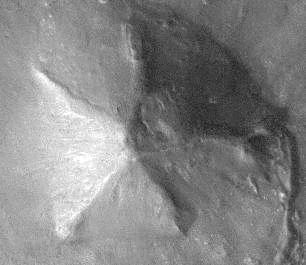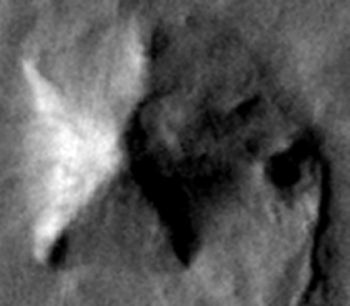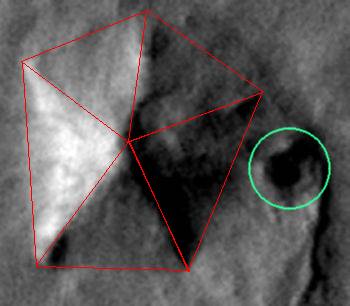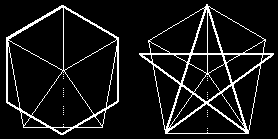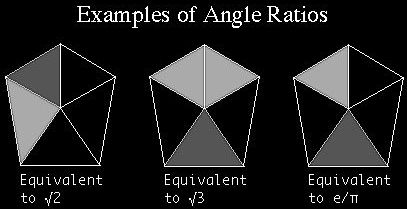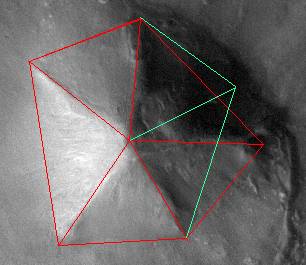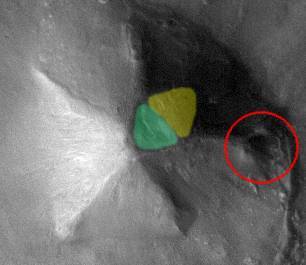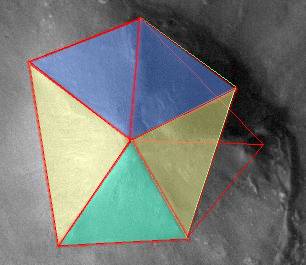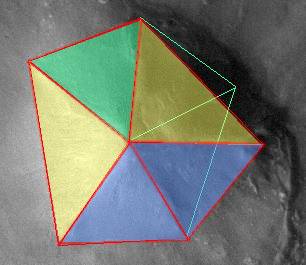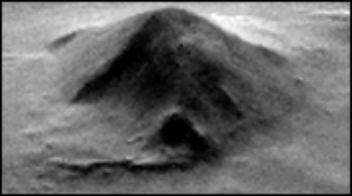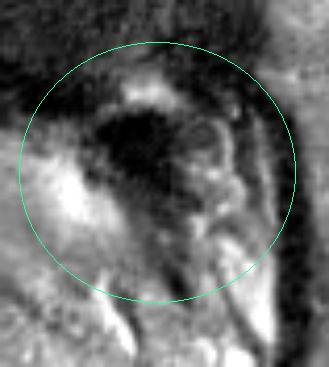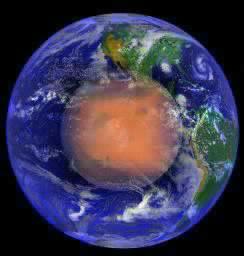 Cydonia Quest C Geometry C C c Mars Odyssey Reveals New Geometry in the D&M Pyramid cccccccccccccccccccccccccccccc C Introduction. On the 12th April 2002 the Mars Odyssey team released a normal optical image from the spacecraft's THEMIS camera of part of the Cydonia monuments area encompassing the "Face", the "Half Face", the "Fort" and the five sided D&M "Pyramid" at a resolution twice as great as the 1976 Viking images, (µµµ). Except for the D&M "Pyramid" all of these enigmatic formations have been imaged over the last four years at much higher resolutions than the Mars Odyssey can achieve by the Mars Global Surveyor orbiter. The D&M "Pyramid" (named after its discoverers, the NASA imaging specialists Vincent DiPietro and Gregory Molenaar) attracted attention because of its regular looking geometric qualities and proximity to the "Face" (click "stargate" for details µµµ). In the Viking image the edges of four buttressed ridglines, together with an isolated buttress (here forth referred to as the Isolated Buttress) formed the corners of an almost bi-symmetrical five sided pyramid. Evidence of heavy damage on the Isolated Buttress's side of the D&M "Pyramid" suggested that it may have once been connected to the peak of the D&M by a ridge line in the same manner as the remaining four buttresses in the pattern. Another feature of interest in the Viking image was the close proximity of a deep walled pit which remained in shadow however much the image was brightened. For this reason it was dubbed the "Bottomless Pit". The "Pit" is circled in the diagram below, which also shows the five sided nature of the D&M seen in the Viking image. C
c Erol Torun's original geometrical observations based on the Viking image. The D&M "Pyramid" clearly showed characteristics associated with artificial structures (not withstanding the fact that it is two miles in length). In a "let's pretend it is artificial" exercise the cartographer and geometrist Erol Torun compared the current heavily damaged layout of the D&M with the pristine shape that it was likely to have eroded from. The geometry of this idealised D&M "Pyramid" had some interesting characteristics. Firstly, it was based on a combination of six and fivefold symmetry as seen in Torun's diagram below. Secondly, the angle ratios within the floor plan produced significant mathematical results (see Torun's examples below) - a technique used in classical architecture. Thirdly, there appeared to be references to tetrahedral geometry within the geometry of the D&M. The latter has been taken by Richard Hoagland to be a celebration of hyper-dimensional geometry by the hypothetical builders of the D&M. Finally, the peak to corner axis lines of the D&M point straight at other Cydonia anomalies such as the "Tholus", the "Face" and the "City Square" in the centre of the "City", (click this "stargate" for diagram µµµ). For a fuller understanding of Erol Torun's findings the reader is advised to read the geometry paper on his D&M Pyramid website, (click "stargate" µµµ). cccccccccccccccccccccccccccccccc C ccccccccccccccccccccccc C The New Geometry in the 2002 Mars Odyssey Image The lighting angle in the new image of the D&M is such that the Isolated Buttress is not as prominent a feature as in the Viking image. It also allows us to see the "damaged" side of the D&M more clearly than in the 1976 Viking image. This reveals that there is actually a fifth ridge line running down from the peak of the D&M to the edge of the "Bottomless Pit", which now shows indications of being the result of the collapse of a hollow mound (of which more later). This better understanding of the actual shape of the D&M "Pyramid" would at first glance appear to undermine Torun's geometrical study based on the Viking image. However, when the geometry of the new shape of the D&M is traced out it appears to be relatively identical to the old geometry - only the orientation is towards the South and not the North. In the diagram (top left) below the red lines show the floor plan of the D&M as revealed in the Mars Odyssey image. The green lines show the floor plan based on Torun's observations using the Isolated Buttress. The two bottom diagrams colour in the D&M "Pyramid" facets to highlight the degree of bi-symmetry in the D&M in the Viking and Mars Odyssey versions of the D&M geometry. It can be seen that a similar type of geometrical pattern appears to have been encoded into the D&M "Pyramid" twice over.
C D&M Viking floor plan------------------------------------D&M Mars Odyssey floor plan
c One thing that was observed in the Viking image of the D&M was a depression near the peak on the side of the Isolated Buttress and a corresponding bulge further down the slope. The Mars Odyssey image reveals that this dent in the D&M has a triangular shape as indicated by the green shading in the diagram above (top right). Interestingly, the corresponding bulge (shown in yellow) also seems to have a vaguely triangular shape. A possible explanation for this correspondence is that the triangular depression has been brought about by an internal collapse in the D&M drawing in the surface above. The collapse of rubble into lower levels may then have caused the surface below the depression to buckle outwards under the internal pressure of the bulging debris. c Some speculations concerning the "Bottomless Pit". The new image reveals that the "Pit" may not be quite bottomless, although much of it is still in impenetrable deep shadow. It can now be seen that the "Pit" is not a hole in level ground but is actually angled into the end of the new, fifth ridge line uncovered by the Mars Odyssey image. This gives it the appearance of a wide tunnel entrance leading into the bowels of the D&M. Interestingly, this impression was predicted in a 3D shape-from-shading image prepared from the 1976 Viking picture by Dr.Mark Carlotto. This 3D image of the "damaged" side of the D&M is reproduced below, with the "Pit" looking very much like a huge tunnel entrance. (An amazing 3D fly around animation of the D&M "Pyramid" by Dr.Carlotto can be found by clicking on this "stargate" µµµ). cccccccccccccccccccccccccccc C If we assume that the D&M "Pyramid" is artificial then it is probably an arcology as theorised by Richard Hoagland and therefore likely to contain a great deal of hollow space, (µµµ). One thing that has been observed about the larger of the proposed "arcologies" at Cydonia is that they are often connected to smaller pyramidal mounds by extended ridge lines or raised "causeways". The classic example is the East Formation in the "City" which is connected to three "Bright Mounds" in this way. Rather than being an intentional entrance the "Pit" appears to be the result of the cave-in of a hollow mound that was connected to the end of the newly discovered fifth ridge line. An enlargement of the "Pit" (seen below) seems to reveal interesting structure in the sunlit parts of it. On this basis the "Pit" should be a priority for the highest resolution imaging that the Mars Global Surveyor can achieve.
Since this inital analysis of the D&M Pyramid was written there have been further developments in the story of it's geometry. A review of these developments can be read by clicking this "stargate" - µµµ. C µ Return to Geometry Page µ Return to Mars Page µ Return to the Cydonia Quest main page |
